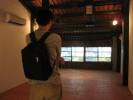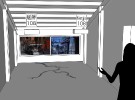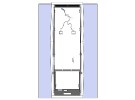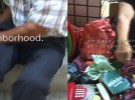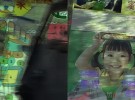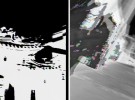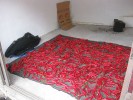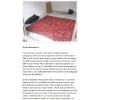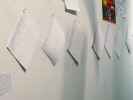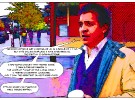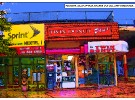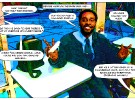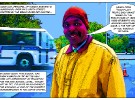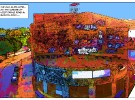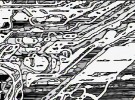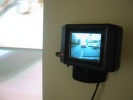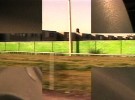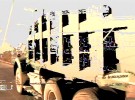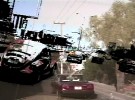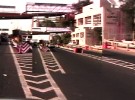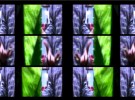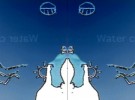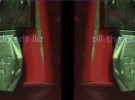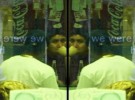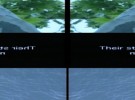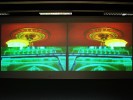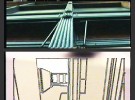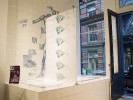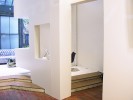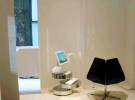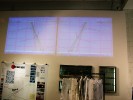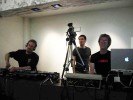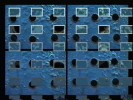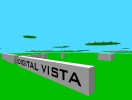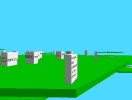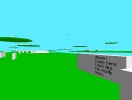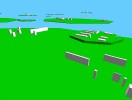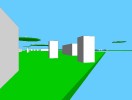720p, 29.97fps, 41 minutes and 45 seconds, two channel video installation, projected on a 107″ x 432″ roll of Super White Set paper.
One of the artworks in Paul Clay’s solo show entitled “Sketches and Memories, (synthesized compositions rendered later, upon the artists’ safe return home)”, Part of the Hudson Vally Center for Contemporary Art’s Peekskill Project V, at ArtWestchester’s The Arts Exchange Building, White Plains, NY, 2013.
Through and invitation from Livia Straus, President of HVCCA, and organized by curator Kianga Ellis.
Painters of the Hudson River School traveled to rather remote natural locations where they made sketches, studies and gathered visual memories, but then trekked back to the safety of their homes (and studios) to make the paintings, often combining elements from a variety of different locales into a single synthesized composition. My title for the exhibit is an oblique reference to this practice.
“Sketches and Memories…” is a collection of works addressing the history of Peekskill and White Plains New York, as well as that of the entire Hudson River Valley. The works combine the subjective and personal with larger forces, tracing geology, prehistory, international politics, and global cultural diffusion to tell the story of the region.
Installation Photo:

Video Excerpt (4 minutes, 30 seconds):
Project Description:
The video artwork “White Plains Story” incorporates subjective bits of White Plains history from interviews and personal experiences, and also looks at the connection between White Plains and New York City, told in the form of a cartoon, collage or animated comic book, and a long scrolling text. The two channels are projected onto a 9 foot high by 36 foot wide roll of white paper, scrolled up at both left and right ends to create a 22 foot screen.
One video channel projects scrolling text, like one might see at the end of a feature film, but instead of credits, the text tells the history of the White Plains area. It involves three sections or chapters. The first covers the history and language of the Native American Lenape who lived in the region for thousands of years, and the Wappinger confederacy who interacted with European arrivals mostly from the 1600 to 1800’s, along with the Weckquaesgeek, band who lived in what was to become White Plains. The second section covers the history of the Arts Exchange Building, where ArtsWestchester is based, and the third, the history of what European settlers referred to as “the white plains”, from the first non-native settlement in 1683 right up to the present.
A second video channel also projects three sections. The artists trip from New York City up to White Plains, a sit down interview with Kathleen Reckling, Gallery Director of ArtsWestchester about her work and her life growing up in the area, and a driving tour with local resident David Licata through various neighborhoods of the city. This second channel is in the form of a cartoon, shot entirely on an iPhone with the ToonCamera app, to convert the video into the visual look of cartoons, and then edited and enhanced in Final Cut Pro.
Both channels are projected onto a 107 inch by 36 foot long roll of Super White Set or photo background paper, evoking the notion of pages in books, and comic books in particular, while at the same time suggesting scrolls which might contain histories or panoramic landscapes. It also references the technology of acetate film with the ends curled up, and the giant binder clips which hold it up the paper screen spaced along it like sprocket holes.
The two video channels, running concurrently, one historical text, the other lush colored cartoons telling personal stories, cause the viewer to jump back and forth between competing narratives, past and present, suggesting a continuum of reality about the region, which must be parsed and filtered to make sense of. All of the disperate competing truths coming together to suggest one possible White Plains Story.
A 90 minute two channel video art installation, involving video projection on paper covered windows in a 100 plus year old Chinese warehouse building, Chalk floor drawing, signage, and lighting.
Presented as part of “Fusion Folks – Contemporary Art Exhibition” Organized by the Taipei Department of Cultural Affairs and planned by Taiwanese independent curator Mr. Sean C.S. Hu. 24 artists both Taiwanese and international, create works related to the Bo-Pi-Liao Historic Center, in the Wanhua District, creating closer ties between art, history, and local customs. Taipei City, Taiwan, from 8/29/09 to 11/01/09.
Installation Photos:
3D Model of Installation:
Video stills of both Channels:
Video Documentation:
[tubepress video=”I5ZJ6oMCwF0″ embeddedWidth=”610″ embeddedHeight=”380″ length=”true”]
Project Description:
Mengjia-108, is a two channel video installation which explores the complex multicultural history of the Wanhua District, in Taipei City, a site of continuous human habitation along the Danshui River, for thousands of years. The title of the work refers to an ancient name for the area, along with the current postal code number. Â Wanhua’s long history and its contemporary status are thus juxtaposed in simultaneous existence. The work employs collage, video filter effects, and text overlay, to present images of past and present, as well as differing viewpoints, angles, and cultural perspectives.
Taiwan has been inhabited for perhaps tens of thousands of years, and the first people in the Taipei basin area arrived around 6000 years ago. These first peoples, or first nations, formed a robust river and seafaring culture. Both they and their language eventually spread all across the islands of South Asia and the Pacific, as far as New Zealand and even the land of the current United States of America. Due to lack of written records and in the absence of large scale architectural remains in long lasting materials, this monumental technological and cultural achievement has garnered little recognition.
Starting in the 1600’s successive waves of peoples including the Spanish, Dutch, Japanese and Han Chinese took control of all or parts of Taiwan, each leaving their mark on its cultural heritage. Throughout this history the Danshui River, and the Wanhua District area have played a major roll.
Wanhua has been an important harbor and trading site for thousands of years, and Mengjia-108 traces some of the disparate viewpoints and little known truths about the area. The Wanhua district has a proud and complex multicultural past, appreciation of which can serve as a guide to the shaping of its future.
Sun Dried Boys (Red Pepper Found Installation), Paul Clay, 2009
Presented in conjunction with (but not associated with), the 2009 Incheon Women Artists Biennale, Incheon Korea.
Multimedia work. Text description, digital photos of storefront installation with red paper-covered windows, television set, red plastic wash basin, flattened cardboard box, two black nets, drying red peppers. Dimensions variable.
Project Description:
Sun Dried Boys starts with a “found installation” or readymade in the form of something already existing, that looks for all the world like an art installation.
The space is photographed and then explicated at length, putting the “installation” in context within the contemporary art scene. The actual artwork consists of the photographs and the text in the form of a fictional “Project Description”. In one way such a work could simply be read as prankster art, but the real intent is to use the found space as a lens to view the art context of which the installation is supposedly a part.
Sun Dried Boys thus explores the social network around the 2009 Incheon Women Artists Biennale, acknowledges folk art and undervalued women’s practices, rips-off or riffs-on, the exploration of other artists work during the exhibit, and acknowledges the gendered power structures that still exist in society and in the contemporary art scene.
The artwork can be viewed at the following url:
http://sundriedboys.blogspot.com/
Presented at the Bronx River Art Center as part of the goup exhibit Metro Poles, Art in Action, a curatorial collaboration between tne Jamaica Center for Arts & Learning (JCAL), the Bronx River Art Centre (BRAC), the Asian American Arts Center (AAAC), and the Maiden Lane Exhibition Space. The work is intended to explore the Bronx, the neighborhood of West Farms, the area’s relationship to the gallery, and the premise of the exhibit.
Here is the comic, in its entirety:
Â
Project Description:
Because this group exhibit is intended to focus on process, blur lines between artworks, and reduce the primacy of the individual artist in favor of a loose integrated net of creativity that blankets the entire gallery – even the act of writing a statement about the individual work could be seen to detract from the exhibit’s mission.
What follows is therefore, not a concise statement but rather a description of participation.
In the spring of this year I was invited by Jose Ruiz, curator of Bronx River Art Centre (BRAC) and Heng-Gil Han, curator for the Jamaica Center for Arts & Learning (JCAL), to submit responses to a set of questions.
They were asking a variety of artists to respond to the idea of an exhibit where artists would make work in a gallery setting and then have it subsequently altered by others. Among the questions asked were: “What contribution can you make to this unconventional exhibition?”, “Can you allow other artists to revise your installation?”, and “Who would be other artists that you would like to invite to the exhibition for the revision and collective art-making?”
The resulting exhibit: “Metro Poles, Art in Action”, is a curatorial collaboration with Jamaica Center for Arts & Learning (JCAL), the Bronx River Art Centre (BRAC), the Asian American Arts Center (AAAC), and the Maiden Lane Exhibition Space.
Â
Among the things I wrote back in my initial response were the following:
“I will photograph in or near the display space – i.e. nearby buildings, back yards, whatever. The available views will function as a filter or organizing principle. This will become the target of research.”
“I will then go out on the street and find anecdotal information from passersby (as well as from people employed by the art institution) regarding who lives there, what business is conducted, what events have been witnessed etc.”
“In a third step I will do further historical research about the visually identified locations on-line. I will then make a collage from the various information materials, printed with ink jet, in a variety of sizes and textures of paper and post the information on the galley walls, like fliers or even gorilla-style like paper street art.”
“All this material, both the physical printing on paper and the conceptual structure surrounding it would then be available as raw materials to use by subsequent artists in any way they see fit. I would simply hope they might function as a launching off point of interest in the creative process going forward.”
I also invited artists Chang-Jin Lee, Marcy Brafman, and Ã…sa Elzén to be “team members” for our group, one of seven groups to work in the space.
For my part I ultimately adopted six strategies, relating to my initial proposal that were designed to explore the Bronx, West Farms, (the neighborhood where BRAC is located), and the area’s relationship to the gallery and the mission of the exhibit.
Â
Strategy One: Gathering images based on a net search for the word “Bronx”
This was a way to begin to understand the visual history in relation to what people have recorded on the internet, about the Bronx.
This doesn’t constitute a comprehensive compendium of visual material for two reasons. First, many things visual known and recorded were done by people prior to the world wide web and those people tend to be less connected, and thus fail to get their visual info recorded to a web readable format, and posted. As a result, much of this human visual archive is missing from a current search.
Secondly, visual searches are still in the dark ages of technology, or in their infancy. Most digital visual images must be “tagged” with text either in their name, metadata (invisible information attached to the digital visual file) or through some similar structure, in order to show up in a search. Smart search engines may also give some weight to images on web pages titled with the search term or in which text containing the term is laid out in close proximity to an image, but this is obviously a tricky mix to accomplish successfully and thus leaves out much of the valuable information that actually has been posted, but hasn’t yet been tagged.
There are algorithms (the most effective of which are currently mostly available only to large corporations), which can search for the actual visual elements of an image, or its genuine “mediatic criteria”, such as color, luminance etc. These can find an image no matter what it has been tagged, but even these currently cutting edge technologies can only look for an image once they already have a base image to compare, so they can find close matches, but only to images they already know about.
All this means that right now, doing a visual search on the Bronx yields a strikingly limited set of results. Nonetheless, it begins to tell some stories about what people, corporations, and organizations valued enough to tag and post.
To display I printed a selection of the results, 16 images to a page, on 8 1/2″ x 11″ ink jet paper, along with the name of each file displayed below it, on 18 pages, and taped them to the gallery wall, much as I might do in my studio.
Â
Strategy Two: Download text related to the history of the Bronx and the neighborhood of West Farms.
I chose 9 of the most compelling texts among many dozen I had saved, formatted them in a formal structure designed to be reminiscent of poems, and pinned these to the wall.
In most cases, the written work was stripped to ASCII text, every comma was removed and converted to a carriage return, and every period was removed and converted to two carriage returns, to create text block separations, and finally the entire text was hard wrapped to 35 characters, to produce short phrases. I did a bit of clean up for readability, printed the texts and push pinned them to the wall.
The texts cover a range of subjects from how the Bronx got its name to the demographics and transportation structure of West Farms.
Â
Strategy Three: Non-linear story telling, through the use of Comics
I have little connection to the world of comics, and never read them as a kid. I came at the format from video art, looking for a way to accomplish similar results, but in a form that allows the viewer more leeway in the amount of time they devote to the process. Still images allow more immediate intake.
The text for the comics comes not from the net research, (as is the case with many of my past projects) but from things that people actually said to me. This is combined with photos that are digitally reworked to become a sort of cartoon or comic book, printed in non archival inks on 13″x19″ mat ink jet paper and pinned to the gallery wall. Various walks as well as interviews with gallery staff and local patrons provided the materials. Some responses also came from emailed questions to specific participants.
Â
Strategy Four: Mapping and modeling the neighborhood
Using a data projector I traced a street map of the entire neighborhood of west Farms onto a big 8′ x 10′ piece of paper and then cut the map roughly out of the center of it and pinned it to the gallery wall. I then recorded impressions about the neighborhood and where I met the people who became part of the comic.
Using a ground plan of the BRAC gallery I made a quick 3D computer model of the space and recorded where the first elements of the project were placed in the space.
I photographed part of an MTA subway map with my phone, showing West Farms, then emailed it to BRAC while on route to the gallery. Once there, I had them print the email with the map and posted it with the other mapping elements. This related to the personal nature of the work and to the idea of the documentarist or participant-observer including information about themselves within the surroundings being documented.
In the same vein, I downloaded an app to my mobile phone allowing me to track my GPS location and record in real time to a version of Google Maps. I posted a printout of one particular tracking event documenting my crossing of the entire length of West Farms, when the MTA train I was taking to the gallery went express and passed my intended stop. I thought, “This must happen all the time, when you live in West Farms.”
Â
Strategy Five: Incorporation with other works.
I placed an old laptop within an arrangement of refuse, which another artist had put together. The computer displays the text from the “poems” I had created from the earlier documentary material, and so creates another avenue of historical communication, and also relates to the work it is situated in by referring to the problem of e-waist.
I Added text comments to artist Marcy Brafman’s work, in the areas where the public is invited to participate.
I filled in several blanks in mad libs left on the walls by another artist.
I created a stick figure comic from one of the many works on paper strewn throughout the gallery, referring to both that work and other art in the gallery, using text from a visitor as inspiration, and which questions what constitutes art.
Â
Strategy 6: Blog and website. I created a blog to document my own progress so that other artists could see what was happening, and am also posting materials to this site.
http://west-farms-studio.blogspot.com/
Presented at Maxwell Fine Art, Peekskill, New York, NY, is a single channel video work which explores the fundamental mediatic qualities inherent in the superimposing of text on video.
Video Stills:
Â
Video Excerpt:
[tubepress mode=’playlist’, playlistValue=’AAF040E7031AA4A0′]
Â
Project Description:
Writing By Cutting is a single channel video work which explores the fundamental mediatic qualities inherent in the superimposing of text on video.
The technical processes of the “matte generator” and “downstream key ” (or DSK), are a means of producing a flat solid-color output which is often used to superimpose or “key” text on top of a video image. In this case what is being written over the video is not text itself but something with visually similar qualities.
The DSK is commonly employed in video industrials during title sequences and show openers, bumpers and interstitials, as well as in corporate video presentations whenever words are needed. Now being eclipsed by motion graphics as the favored mode of text presentation, this ubiquitous visual event has become cliché.
In early film work black mattes were cut by hand and placed over sections of the image to allow compositing. Today av mixers generate simple mattes on the fly, cutting out parts of the image and replacing it with text. Writing by Cutting takes this common yet ephemeral video occurrence and strips it down to essentials, as a means to make its fundamental structure apparent.
Created using an industrial audio/video mixing console and with no video content or text source material whatsoever, the “program” output of the mixer is redirected back into one of the input channels to create a delayed feedback loop. By keying a matte over the feedback and carefully riding the luminance levels, semi persistent lines can be inscribed over the channel below. Newly recorded material is written to the foreground as the older fades into the background giving an illusion of multiple planes of depth.
The process itself is done live, by hand, and is delicate to achieve and to control. The “writing” process reveals fundamental mediatic qualities inherent in video imagery itself, and explores the visual meanings embedded within these structures.
A one hour long, two channel, three screen, dvd video installation. Created through a live video mix performance, it deals with street level architecture, globalization, and the meaning of work, home, and place, and was presented in the group show Une promesse de malheur, curated by Edgar Orlaineta, at GAM – GalerÃa de Arte Mexicano.
Video stills and photo documentation of the installation:
Â
Video Excerpt [4min, 53sec]:
Note: Best watched in High Quality – Click video once to play, then after video begins click the “HQ” icon on the lower right. Video will restart in High Quality.
[tubepress mode=’playlist’, playlistValue=’2802BFB8249A419F’]
Project Description:
The first part of the title refers to two cities, New York (NY) and Ciudad de México, Distrito Federal (DF), and the second part translates in English as “going to work, going home.” The piece is created from footage shot in both cities, recorded by the artist and a range of people who work at the GalerÃa de Arte Mexicano, focusing solely on traveling to work and traveling home. The video footage is mixed with satellite photography, maps, and various forms of business and other data, suggesting the socioeconomic as well as geographic connections between the two cities.
As Mexico City grows, working people move further and further into the expanding periphery and one can see the infrastructure of highways and services struggling to keep pace. This same overflow leads some to travel North and there has been a huge new influx of laborers into the New York City area, helping power that city’s economy from the ground up. The energy of this expansion is echoed in the hard driving and rapidly changing “music video style” imagery used in the artwork.
NYDF Concentrates on the activity of going to work and going home, cars honking, drivers cursing, changing radio stations, traffic jams, and an almost comedic sense of being overwhelmed by the journey. Yet despite the “club visuals” style, the piece ends with arriving home and the simple pleasures of children and family. That is, until the epilogue, in which the whole thing starts all over again.
Advertising, shopping, architectural development, corporate media – these are complex cultural processes that are colonizing and overtaking public space. A kind of Global and urban sprawl is creating a hither-to-unimagined world that we now must function in on a daily basis. This encroachment endangers the creative environment needed by every individual. The urban street-scape is being converted more and more to a site of corporate bombardment and endless counterproductive transport, rather than community interaction.
NYDF represents an attempt to look at what we have made around us, to wake up to our own participation, and, at the same time, to honor the beauty and immediacy of individual lived experience in the present moment.
Contributors to the project: Lourdes MarroquÃn Hernández Edgar Orlaineta Mariana Pérez Amor Faustino Serna Nuñez.
A one hour, two channel video work, commissioned by the Hudson Valley Center for Contemporary Art.
Video Stills:
Photo Documentation:
Video Excerpt:
(Note: Best watched in High Quality – Click video once to play, then after video begins click the “HQ” icon on the lower right. Video will restart in High Quality.)
[tubepress mode=’playlist’, playlistValue=’41558420184570AA’]
Download PDF of the New York Times Review:Â
VIDEO REVIEW; “The History of Peekskill, as Collage” By BENJAMIN GENOCCHIO, Jan 23, 2005
Project Description:
“When We Came” tells the story of Peekskill from the dawn of human beings, and uses the Hudson River as a point of focus. The mirrored video makes reference to water as reflection and to the flip side of history that we are seldom aware of, an angle from which our own language and perceptions seem foreign and “other”.
It begins with the text of an African creation myth from Ghana. Africa – the origin point for human kind. A great number of African Americans originally came from Ghana and most passed through Almina Castle in Cape Coast, a Dutch fort in the slave trade. Peekskill has been a key center in African American development and resistance in the New World since before the Revolutionary War.
The African myth explains the origin of Water Sun and Moon, and why Water still lives with us on the earth. Peekskill is about water, about the Hudson River. It formed from a retreating glacier at the end of the last ice age. It is a New World that has been continuously being rediscovered for the last 12,500 years. The early Native American Paleo People, the Shield Archaic people, the Mahicans, the Iroquois, the Wappinger, and the Kitchawak an Algonquian people, who lived in the town of Peekskill or Sackhoes, as they liked to call it, before the European peoples ever even arrived.
The story of Peekskill is about visitors coming up the Hudson from New York. This includes Jan Peek, for whom the town is named, (“Peek’s Creek” in Dutch) who lived in the settlement of New Amsterdam which was later renamed New York. Jan came up the Hudson to trade with the Kitchawak at Sackhoes. Other New Yorkers also traded goods by boat and later by car and train. They brought ideas too. Young Russian Jewish women fleeing the nightmare of the Triangle Shirt Waist Factory fire and trying to start a better life free of labor exploitation. African Americans coming up from the AME Zion Church, and from Harlem, working towards equality. Soho artists driven out by soaring real estate prices looking for a place to create and express their art.
They came from other places besides New York too. The Italians, the Irish, the Chinese as they built the railroads. The British first to burn the place, and later to establish families. African Americans fleeing slavery in the South via the Underground Railroad. Equadorans, Guatemalans, and others from even further South, looking for a better life.
There is a long and tumultuous history of arrivals in this place, filled with great strife and great beauty. We are only the current caretakers and ours is a momentary passing in the long history of the river valley. The “Muh-he-kun-ne-tuk” – as the Mahicans would call it when they first came 6000 years ago. “The place where the waters are never still”. In this work we too arrive. The strangers, the outsiders, the new comers. We try to document, to make a record, so others who come after can know what we experienced, how we felt. So they might see what we saw – when we came.
Conceived by Paul Clay, Video Mix: Paul Clay,  Audio Mix: Arrow Chrome.
You Are Here – architecture, retail, and locality:  an art installation and live audio/video performance contemplating the neighborhood of SoHo and the nature of shopping and retail design, created for the Diesel Denim Gallery, a clothing store where 70% of the space is devoted to the presentation of art, and which is located in the SoHo neighborhood of New York City.
Â
Project Description:
There are seven basic elements of the installation:
1. Foam Core Wall:
A 40 foot long by 12 foot high fake wall built from 1/2″ Foam core. It is a one to one scale replica of the actual wall opposite to it, but in mirror image. The wall promotes the idea of the store existing as much in the design phase as a foam core white model as it does in the “real” phase. The mirror image is also a kind of reference to the mental inversion of the “Gruen Transfer”.
2. Floor Sticker:
The 22 foot long vinyl floor sticker with a red dot and the phrase “You Are Here” refers to both the placement locator help found on maps in public spaces, but (like the foam core wall) also serves to suggest that the shoppers are not in an actual space but a space modeled around them and to control them. As though they are ant sized in a model box designed to look like a store. The fact that part of the sticker seems to be sitting underneath the actual brick interior wall of the store serves to further dematerialize the structure.
3. Plexiglas Plaques:
Six hanging C prints on plexiglas 32″x48″ which contain elements of text, and when taken together say the following: “Shopping can be a disorienting experience. Have we found the right place to fulfill our dreams? Where are we in socio-architectural terms when we are in Soho shopping? You are Here.”
4. Clothing rack hanging Plaques:
1/8 inch thick, 24 inch by 30 inch mat white plastic plaques, designed to hang among the clothing that was being sold. These are intended to be roughly the same size as the garments themselves and are hung on hangars, just like the clothing. Text written in black marker in Seven different languages: English, Spanish, French, German, Italian, Japanese, and Korean, gives pointed information about the historical development of retail architecture and the effects on shopping. (This turned out to be a particularly effective intervention in that Soho is filled with tourists and with so little support in the US for foreign visitors, they strongly gravitated to, and took interest in, something written in their native language.)
5. Map of retail development and in-store design:
A 73 inch wide by 77 inch high hanging map printed on the vinyl used for architectural “building wraps” (the very large scale billboards on the exterior of buildings) displaying visual details about the interior and exterior of the store, details about the individual interventions in the installation, text info about the neighborhood and the history of shopping, and time lines for the Evolution of Retail Mechanisms, Retail History, and the Diesel Denim Gallery. Important developments such as Joseph Paxton’s Crystal Palace, and the first know use of mannequins are noted. The history is tracked into possible futures including synthespian sales staff.
6. Satellite view of the store with data overlay:
Hanging print of Satellite view of the neighborhood along with data overlay relating to retail space use in the neighborhood of Soho.
7. Interactive 3D Fly through:
A computer and projections at the back of the store, behind the foam core wall containing an interactive 3D fly through of the store with slabs floating in space giving information on everything from the number of daily visitors to the store, to the amount of air that passes through the air conditioning system each month.
8. Video projection:
Video projection from three projectors, of the video collage made during the live mix performance, Which included a walk and drive through of SoHo, close ups of design details about the store, text on retail Design, live video of the audience in the space, and 3d fly through of the info time lines.
Â
Project Description:
When I was first approached by curator Sebastien Agneesens about the possibility of creating a work for the Diesel Denim Gallery I thought, what kind of artwork could possibly stand up to the retail environment and not get eaten by it, not turn into advertising for the products around it? I decided the only likely work would take on the structure of retail architecture itself, as a subject, and though it would still be ground up and consumed, it might transmit its meaning virally in the process.
As is pointed out in the brilliant and encyclopedic tome “The Harvard Design School Guide to Shopping”, shopping is everywhere these days. The museum, the airport, the nightclub, the university. Shopping is blending with or replacing, almost every kind of urban activity and has become one of the main ways we experience life in a city.
Though shopping is one of the most temporary and unstable types of urban activity, contemporary cities are attempting to use it as the main building block or foundation for civic life. Shopping is not a viable alternative to fundamental communal activities and services, because it doesn’t necessarily last. Shopping has a vital place in society but should not be made to do the job of institutions.
Shopping architecture is cheaply made because like fashion it must constantly change. Buildings can last for 5000 years, but shopping architecture is currently typically viable for only about 3 years before it must be completely transformed into something new.
The timeline for retail development is so brief that stores go from model to completion to obsolescence in almost no time at all. Retail architecture is ephemeral, lasting a brief moment. Existing as much in the design and model phase as in the actualized phase, the store itself is there for such a brief time in historical terms as to make it like a momentary reflection, like a model, hardly real.
Even when realized, retail architecture is often so cheaply built as to be a facade. Like a Hollywood back lot. Like a movie set.
The store exists as much as data as it does as physical building materials. Realtime information tracking, computer modeling of consumer behavior, constant monitoring of shoppers through multiple forms of surveillance media. The store as a virtual and data construction is much larger and more real in some ways than the puny physical location. Even the idea of “brand” and the projection of brand out into the world as advertising can be considered part of the virtual extension of a store.
But the physical locale has its advantages and has a depth and breadth unknown to the virtual trackers. The window washer who wants to address issues of race with passers-by. The gum on the sidewalk that records a trace of the life of a breathing person at this locale, the stone, the iron, the rain on your face. The beauty of being alive in the present moment.
Shopping spaces are designed to delight, but also to confuse and mesmerize. In retail architecture huge amounts of time, money, and research is devoted to this. Scripted disorientation is used to actively confuse shoppers so that they become more susceptible to making impulse purchases. The Gruen Transfer, (named for the first shopping mall designer,) is a psychological state where movement slows, eyes glaze over, jaws slacken and the mind temporarily ceases to function properly because it is experiencing too much input. The exact distance in feet and the number of seconds it takes to induce this debilitated state is actively measured in contemporary retail design.
In ancient times there was a market outside the borders of the city. People went there to exchange goods. There was no buying and selling organized inside the town. In the current era shopping is one of the major forms of urban activity. Imagine a modern city where there was no shopping. What kinds of activities would you do in a city like that? What would be important? What would you care about and devote time to? What might constitute meaningful civic and urban interaction?
Shopping, like advertising can’t simply be discontinued because it is being used in contemporary society to fill deep seated needs, and there are currently few social structures to replace it. If we at least begin to become aware of the lengths to which designers go to alter our consciousness as we go about the process, then we can begin to shape our own outcomes from the experience.
Toward this goal, the project records, through multiple forms of digital media, the local environment in the neighborhood surrounding the gallery. It gathers, in this case, intimate details of life in Soho, New York. In addition it creates an architectural and mediatic intervention into the actual space. Research on the historical development of retail, information flows, the nature of shopping and the meaning of place is presented in dynamic visual, audible, and textual form, heavily layered and worked.
Media forms include a stripped back 3D computer model of the entire store with text replacing products, a 3D data map of retail and shopping, satellite photographs, digital video, still photography, and audio samples. All these mediatic elements are combined in an A/V performance work created live, in the gallery, and then subsequently on display for the duration of the installation.
Shopping can be a disorienting experience when we are offered so many possibilities regarding place, design, and personal style. Have we found the right place to fulfill our dreams? Where are we in local, architectural, geographical, virtual, and cultural terms when we are wandering around in Soho, shopping? The project gathers the mediatic traces, then lays it all out for you. At the Diesel Denim Gallery – YOU ARE HERE
Credits:
Concept and realization: Paul Clay with curator Sebastien Agneesens
Live Video Mix:Â
Video – Paul ClayÂ
Audio – Arrow Chrome
3D Data Mapping: Jose Salinas, Architect, founder of Knobs Design
3D Animation: Paul Clay, Willyum Delirious, Jose Salinas
Publicity for Fictive: Berit Fischer, Naiying Kuo
Installers for Fictive: Julie Allen, Mark Power, Chang-Jin Lee, Yukiko Hayakawa
Translations for Hand Written texts: Jose Salinas, Yukiko Hayakawa, Sebastien Agneesens, Berit Fischer, Julie Allen, Chang-Jin Lee
Curated by: Sebastien Agneessens – Formavision
Special thanks to all the people at Diesel, from those at the top who approved this thing to those who did publicity, install, letting us in after hours, and supporting us as we did the work. You made this event possible. Thank You.
You are Here is a project of Fictive, a loose constellation of multi-disciplinary art creators, and a kind of fictional arts collective founded by Paul Clay and composed of whoever happens to be working on aproject at any given moment.
A one hour long live video mix performance which contemplates the meaning of locality and place in contemporary society, presented first at Magazin 4, Breganz, Austria, and then as part of the 10 year anniversary of the Kunsthalle Wien, Vienna, Austria
Â
Project Description:
Imagery and sonic details of the local space are meticulously recorded. This includes everything from stair rails, handles, and window joinery, to snippets of street conversation. Following this details of the street level built environment in the city and the surrounding vicinity of the place to be contemplated are documented. This imagery is then mixed live in real time on the evening of the performance, along with live cameras, text about place and architecture, and performative elements evoking the nature of recording, inscription, and display.
Despite its use of carefully gathered documentary detail, the live mix and filtering process attempts to devalue contentism or focus on narrative elements. Instead it evaluates the raw visual and aural content, and reconfigures this to tell its own story, more as nonfigurative painting is understood to convey meaning. Multiple simultaneous video projections created by mixing a host of inputs including videotape, infrared cameras, and computers are employed. The work brings the energy and structures of the club and alternative happening scenes into play with a slightly more contemplative and philosophical approach to generating meaning. The work is an attempt to use the current tools available in new media to explore the age old question of what it means to be, to inhabit.
The work also has a strong ludic component. A reshaping of the interaction of the individual with the environment – not following a normal culturally dictated path or set of instructions. Not even directly accomplishing a culturally prescribed or proscribed goal. Discovering. playing. Like a Trickster figure, the artist comes to your “place”, like the very first human being, like the character of Coyote in Native American myth, loving life, sharking around and looking for things, not following the rules or even aware of them, gouche and unschooled, what does he see? What gets recorded? What can be revealed? …and then there it is, its all on display. Displaced and played with. Creating a sacred event or performance, a celebration, where the core qualities of a place may by chance be revealed. Dis-Play.
Â
Â
Some Background Theory about Dis-Play
How natural and man-made places embody meaning – the spirit of place:
“There was a house made of dawn. It was made of pollen and of rain, and the land was very old and everlasting. There were many colors on the hills, and the plain was bright with different-colored clays and sands. Red and blue spotted horses grazed in the plain, and there was a dark wilderness on the mountains beyond. The land was still and strong. It was beautiful all around.” – N. Scott Momaday
Native American plains peoples have a huge respect for land and place, born partly out of harsh environment, but much more from thousands of years of tradition. They understand the value of knowing a place through deep lived experience. We, also, can feel deep meaning in volume and expanse in the natural environment. Everyone who has been to mountains, deserts, forests, and oceans knows this on a visceral level.
In addition there are small localized physical forms in the land which bespeak place on a gut level. In Iceland there is a belief that “Hidden Men” or spirits exist in places that have a special character. Roads get built around significant boulders or depressions in the environment lest the spirit of the place be disturbed and cause bad luck. Why is this the case? Simple-minded folk tradition? Maybe not.
We can feel the specialness of the place around the boulder, and if it is removed the valuable experience is gone. The feeling IS a manifestation and can be understood as the spirit of the place. Removing the boulder disrupts the spirit, with grave consequences for those who will have an emptier life as a result of its loss. The mystical invades directly into our 21st century experience. As film director Hal Hartley put it after shooting there: Try to use the rules of what you believe. In Iceland, they don’t apply. You can attempt to fight the volcanoes, the ice, and the sea – but you will not win. These things have a truth far beyond our meager knowledge.
Aboriginal peoples in South Asia carry a sacred stick with them as the community travels from place to place. They understand the stick they carry as a direct connection between heaven and earth, and that the stick is at the center of the world, or rather, IS the center of the world. The center shifts and travels with them as they go. They are always in the spiritually vital center place.
Similar spatial meanings to those we experience in the natural environment are also conveyed to us, in varying degrees, through architecture – but in the case of architecture we are making the boulders and sticks.
Â
Architecture as natural human excretion:
James Turell once said to me he thought people were much like hermit crabs. Having no shell of their own, but needing one always, they would go from one empty shell to another as they go about their business, home, to car, to building, finding/making new shells and staying protected.
He also said he didn’t believe we had much more control over the urban sprawl of Manhattan, than coral do over the Great Barrier Reef. It is a process we are a direct and active part of, but do-not/can-not control. Architecture is a physical manifestation of our “being” on the earth. The outcome of a system we only think we regulate, an actual material excretion of our collective physical organism, a trace of who we are. What information is contained in that trace? How does how we conceptualize what it constitutes change what it actually is and means for us?
Â
Inhabiting – Home and the center of the universe:
“In every dwelling, even the richest, the first task of the phenomenologist is to find the original shell” – The Poetics of Space, Gaston Bachelard
We can feel the same gut level responses to the volumes of the built environment as those of the natural if we but allow ourselves to be attuned to them. The marking of the passage from the world of the secular to that of the sacred and back again, feeling the little openings onto some other kind of experience, the sense imbued in us by structures and the expression of physical and design forces within them, the reach and extension, the amplitude of a space, the vaulting and volume, the materialization of ideals. Yet, as Bachelard says, conveying the meaning of place is not simply about describing the architecture and built environment of an area, not a kind of travel brochure enumerating the picturesque features. Rather it is about getting down in between the crevices in the cobblestones, the alleys between the sky scrapers, and getting to the liminal core: what does it mean to inhabit, to have a place which is home? What does it mean to be in a place which is yours, or to go to a place that is someone else’s? To navigate memory as well as the physical environment in the street.
Â
Mapping and addressing, limits of the 3D Western perspective:
In the documentation for an artwork Laura Kurgan did at Storefront for Art and Architecture, a GPS manufacturer’s brochure is quoted as saying “GPS receivers are fast becoming small enough and cheap enough to be carried by just about anyone. That means that everyone will have the ability to know exactly where they are, all the time. Finally, one of man’s basic needs will be fulfilled.” Part of the failure of insight on the part of the brochure maker is the belief that dividing everything into a Cartesian grid and plotting points on it constitutes knowledge of place. It is far more than a geographical question. Knowing where you are is not just a matter of orienting one’s self in Western 3D space, but of having a sense of one’s relationship to ones surroundings and the universe. When someone faints and they don’t remember at first where they are, they do not regain an understanding from being told a GPS location, they know as they remember the circumstances of their life up to the present moment.
Â
Screens, Media Networks, virtual architecture, and augmented space:
Answering the question of what place means is further complexified by our current ability to operate telepresently across aural, visual, and textual networks and to be at play in a set of ever shifting data nodes across a variety of fields from geopolitical, to corporate database, to global market.
In order to handle this additional layer of place the developed world is becoming increasingly display-centric. We rely on displays in our phones, PDAs, computers, televisions, cars, digital audio players, and domestic appliances to help envision, direct and control the necessary flows of data. These aspects of place are more and more being integrated into architectural design, so that the design contains both physical and data space. It is currently referred to by a variety of names including Virtual Architecture and Augmented Architecture. It should be noted that this is not a reference to 3D models used as a design guide for building, but rather to screenal and data space directly incorporated into the finished architecture. A new part of the built environment.
As Lev Manovich notes in his The Poetics of Augmented Space: “Going beyond surface as electronic screen paradigm, architects now have the opportunity to think of the material architecture they are normally preoccupied with, and the new immaterial architecture of information flows within the physical structure, as one whole…the design of electronically augmented space can be approached as an architectural problem.” So the question of how data travels and impacts place gets addressed through architecture.
Â
Travel, morals, and cultural flows:
Data isn’t the only thing that travels and effects meaning. The physical movement of people also has a huge impact on place and tradition. There are effects on both those who travel and those who are visited. There is an aspect of societal escape in travel. College kids on spring break in Florida operate on an entirely different set of moral standards than they do at home. There is a traditional Japanese saying which translates something like: “Shameful acts committed away from home may be forgotten.” Travelers, when away from their “place” lose certain cultural restrictions still in force for those who stay at home, because the forces of place no longer hold full sway.
Interestingly, this liminality, disruption, or displacement actually takes place for local residents of a place which is visited. Flows from one way of thinking meet with local internal flows blending or bubbling up in fluid dynamic. The outsiders bring a disruption of world view, a change in the status quo. Local moral and cultural disruptions can occur, a complex combining of things jostled together and not yet sorted out. A sometimes uncomfortable reframing of point of view is forced on all concerned. Many things are kludged on top of each other that exist temporarily or temporally in mixed form – keyed cut and layered on top of each other in crazy, unorganized, not yet properly mediated form – the new world view, not yet sorted, and the liminal areas dangerously exposed. Hidden truths about unquestioned assumptions are brought vividly into focus. Things spiral dangerously out of control only to be brought back into new kinds of patterns. Secret trysts with travelers which go unreported to wives or boyfriends. A longing for the artificially conceived exotic place of the travelers origin, or where they have passed through, and a wish for release from local cultural responsibilities and oppressions. An expansion of who one can be. Real places taking on iconic meanings for visitor and visited.
Â
Tricksters and ludic behavior:
Travelers can take on qualities of the trickster figure from Native American myth. Paradoxically, the trickster helps to define place by failing to follow the normal locally-dictated path or set of instructions. He will not even directly accomplish any culturally prescribed goal. The figure of Coyote is a good example. Typically arriving on the Earth just before the first human beings, he is gross and not yet fully formed. Though utterly uncultured (because he has arrived to invent it) he runs about goofing off and causing problems, a bad boy, but in the process he lays the groundwork for what people will make, and how they will need to behave in order to get along. It is his undirected energy, ludicrous and ludic, which helps define how things should and should not be. A visitor discovering, playing, inadvertently revealing the qualities of culture, and place.
Â
Observation and recording:
For the visitor interested in exploring and capturing these qualities of place, recording poses an interesting dilemma. Recording impacts negatively on ones ability to experience and understand, and yet is vital to help fix the observations one is able to make. Recording, say for example through video or photography, is a very shallow or hollow capturing of the total truth of place. It disrupts the process of actually being there and participating, and in no way comes near to describing the full view of those visited. The camera can’t track back far enough to get the smell and the fact that your daughter skinned her knee here three years ago, or that you secretly dream of owning a house on that hill one day, and in your mind it represents the fulfillment of the life you were meant to have but have not yet achieved. That when you see that tree, or that corner Bodega, you feel a tiny almost buried thrill in your heart because you KNOW you are home. As visitors, we can’t be in the shoes of the people, we can only do “participant observations” from our own perspective.
In attempting to record someone else’s place, one inadvertently gets documentary based on the momentary ephemera of one’s own lived experience. So be it. With luck, one can also capture a bit of the economics and metaphysics of the built environment. What is gum on the sidewalk like? How do traffic systems work. Where should cars stay out of? Where should they stay inside of? What materials are used to build and how do they get joined together? Showing the functioning of contemporary culture on a physical/anthropological level. Again, what are the traces, and how can the more ephemeral meanings which do get recorded in this shallow, pale, or freeze-dried form, be most effectively reactivated and displayed?
Â
Live video mixing, mediatic criteria, and the politics of filters:
Converting media into digital data creates “the unforeseen option of addressing not only images (by frames) but even every single picture element (pixel). Images and sounds thus become calculable and can be subjected to algorithms of pattern recognition – procedures which will “excavate” unexpected optical statements and perspectives out of the audio-visual archive which, for the first time, can organize itself not just according to meta-data but according to its proper criteria – visual memory in its own medium (endogenic).” “not only images become addressable in mathematical operations, but their ordering as well can be literally calculated.” – Wolfgang Ernst, A visual archive of cinematographical topoi: Navigating images on the borderline of digital addressability
Though Ernst is discussing of the philosophy of archives, the algorithms he refers to are exactly what video mixing is based on. Filtration of video signals devalues subject and instead favors formal elements such as volume of luminance, hue and chroma, contrast, and scan line or pixel variation across time. The artificial conceptual structure of line drawing can be applied as filter by selecting edges and augmenting or flattening them. All of the filtering is based on the mathematically analyzed visual properties of the images, on what Ernst calls the genuine “mediatic criteria” of the image.
Visual properties are further complexified by The blending of multiple live video streams so that they mutually infiltrate one another and exhibit permeable boundaries, the primacy of the individual frame broken through keying, cutting patterns, and other algorithmic means of compositing. Paradoxically, this seeming obscuring of the image through manipulation actually opens up a whole range of meaning-generation similar in some way to non-figurative painting. It thus reanimates the ephemeral messages, allowing us to bring them to the fore, and to add depth, to amplify the weak signals, to make these simple things full again, to allow them to be multi-vocal once more. It makes it possible to put back meanings which get lost in the shallow process that video recording constitutes, to reconstitute, and to add new meaning as well.
Â
The meaning of display:
To display is to expose to view or allow to appear, to reveal. It is the presentation of signals or data in visual form, or the physical object on which the data is manifested. Display is a revelation of things which are already there, but need a mechanism, a guide or some letting-loose in order to be fully seen or understood. Video not as screen but as extension, architectural, intellectual, amplified light, but not only in terms of lumens. Amplified across a whole series of Axes, datacly, mediatically, socially, poetically, to reveal not only mass and structure but a narrative of the soul. The screen as gate of heaven, as entry point, passage, membrane, a plane or liminal transition moment onto the sacred beyond. An opening onto, an event horizon.
Â
The sacred and the everyday:
“People sometimes get good at blotting out the sights and sounds and smells around them…perception, when it resurfaces, can catch them by surprise.” – Tony Hiss, The Experience of Place
The possibility of a special encounter, a moment’s awareness, exists at any given instant and can be triggered by encounters with physical places. It’s where these spirits or potential moments of contemplation and awareness reside. In spaces. In localities, in a particular place. A billion little gates to heaven, waiting to be discovered. The values of the sacred reside deep in the heart of the everyday, in the cracks in between categories, in the things we make. the spiritual is directly embodied in physical form in the built environment. It contains our “hidden people”. the extruded aluminum of the prefab window sills in Tokyo or the molded plastic fender of a bus in New York City contain, in physical form, the triggers of familiarity, the qualities of volume and form, the manifestation of the spiritual value of home and place, of our deepest unvoiced feelings. Talismans of the built environment. The hidden can come out and speak to us.
Â
Dis-Play:
“People tend to suppress that which they cannot express. If an experience resists ready communication, a common response…is to deem it private…and hence unimportant…relatively few works attempt to understand how people feel about space and place, to take into account the different modes of experience (sensorimotor, tactile, visual, conceptual) and to interpret space and place as images of complex-often ambivalent-feelings.” – Yi-Fu Tuan, Space and Place: The Perspective of Experience
With Dis-Play we celebrate the mundane and often overlooked qualities and meanings in the built environment, the things you can’t quite put a finger on. We honor the importance of locality and site, bringing everyday experience to the plane of the sacred and contemplative. Looking at a hand, a brick, a street, a piece of chewing gum, we see the world we have created.
“That’s why we seize the moment try to freeze it and own it, squeeze it and hold it, cuz we consider these moments golden” – Eminem
It is an attempt to get a grasp on, or gain insight into – who we are, to get in touch with ourselves through the portal of architecture and the street level lived experience. Architectural details, interior and exterior elements merge and mutually infiltrate one another, the screen becoming a mediation plane between the secular and the sacred, a permeable membrane our souls can pass through to see beyond the detail – to the whole of the picture of who we are, at this moment, on the planet. What is it that we are? And where are we, not just in the universe, but directly, right now, locally? To define where we are in a way that you can know it, not just conceptually, but on a gut level, in your heart. Like a taste on your tongue. Like a scent memory that takes you right back to the moment. Like a place you know. Like home.
Installation involving a 3D Computer model consisting of a navigable mile-wide virtual cube of visual and textual information.
In the group exhibit BAD SCIENCE, INTERACTIVE INSTALLATIONS AND FABRICATED DIALOGS, presented by mixed mess@ge, in association with The DTW Gallery, New York City
View screen captures:
Project Description:
The title refers both to the look of digitally produced landscape, but also to what’s on the horizon if present trends in our cultural perception of space continue. The work can played with like a big video game you fly around in and explore, but my hope is that for some it may be viewed as a sort of critique of western visualization. It is about the Western historical perception of landscape in the most basic sense.
Â
Digital Vista
Review by Chris Jordan
[abstract]
Digital navigable environment projected on surface of metal tube cube approximately 8′ x 8′ x 8′; two facing surfaces covered and used as digital projection space; pillows, carpet, keyboard and trackball.
[details]
Digital Vista is a multifaceted artwork that questions the massive societal movement towards all things virtual. It blurs the boundary between digital and tangible through viewer interaction, both physical and mental. The traditional role of artist-audience is torn down through the collaborative and interactive nature of the installation.
This is a participatory artwork, utilizing the calm stillness of Zen to create a gateway into the virtual experience. The real life space, contained within the square mesh, welcomes you as well as supports you through the virtual experience. Once you are seated and Paul has coached you, like the Zen master, on the controls, you begin the exploration. The first thing you see are three dimensional green lillypad-like extrusions floating on a cyan background. Zooming into these stark structures, you notice gray tombstone-like obelisks on them. Further navigation towards these obelisks reveals simple words and phrases on their surfaces. As you stop and look around these spaces, you begin to notice words combining into more complex thoughts as different obelisks line up in 3 dimensional space. While shifting around these cubes, the combinations change; some disappear, some emerge, positions are altered, and you begin to realize the delightful complexity of this experience.
Your mind soars, dreamlike, while your body rests comfortably within the peacefulness of the cushioned cube. For me it felt like an out of body experience. I zoomed from lillypad to lillypad, creating different motions, rhythms, and phrases out of the objects. It was exciting, thinking of Burrough’s work with audio cutups in the 50’s, conjuring 3D meaning out of the recombination of words. The smooth response of the system allows you to hunker down in a cluster of cubes, and spin around, the words and shapes combining in a blur of meaning, form and phrase fusing into one.
As I became more immersed, the starkness of the environment created a feeling of walking through a graveyard. I then interpreted these tombstones as a memorial to the actual words written on them. Initially the flash and discov- ery of this virtual space gave the Digital Vista meaning, showing humanities moth-like draw to all things bright and shiny. But paradoxically it is a statement on how that flash is eroding society’s connection to not just literature, but the use of words. We see this every day, as more and more people turn on, and tune out. People have been reading less and less, opting instead for the somnambulism of television, and the bang of video games. Digital Vista not only questions that shift in society, but creates a memorial to the casualties in this future atmosphere.
The Dadaist notion of the “Exquisite Cadaver” opened the 20th century with word play exploration as an art form. Now at the close of the century, Paul Clay’s Digital Vista is appropriately representing the use of language or words as the modern Cadaver.
Project Credits:
Digital Vista by Paul Clay
Text: Karen Williams with additional text by Paul Clay and Ed Pastorini.
Early versions of the presentation included contributions by Yuki Takagi, Willyum Delirious, and Jamie Leo.

